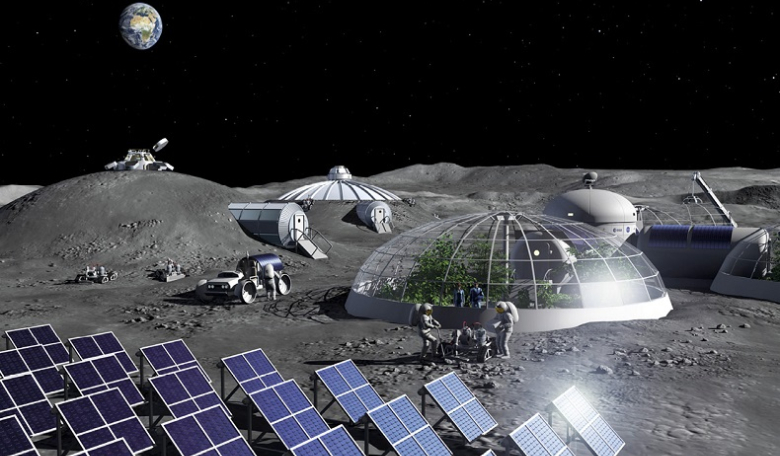The advent of a new era in spaceflight, and especially human spaceflight, has resulted in numerous exciting and creative endeavours, such as Artemis and Moon Village, with the goal of prolonging human presence both on the lunar surface and in low Earth orbit (LEO). Further concepts and developments are built on the premise of humans reaching Mars in the future. The actors in human spaceflight are becoming more and more numerous. Contributors to these undertakings come from all over the world from academia, commerce, industry and even the general public.
To ensure long-term presence of humans on other celestial bodies such as the Moon and Mars, but also in LEO, requires structures that supply functionalities to survive and fulfil the goals and purposes of a given mission. These structures, space habitats, must serve to satisfy the needs of humans and their missions. A space habitat provides shelter from environmental hazards, such as the vacuum, extreme temperatures and radiation, while affording crew life support that includes water sanitation and air revitalisation. It further provides a workspace and other functionalities depending on the exact purpose of the habitat, which can be commercial, scientific research, tourism or a mixture of various intentions.
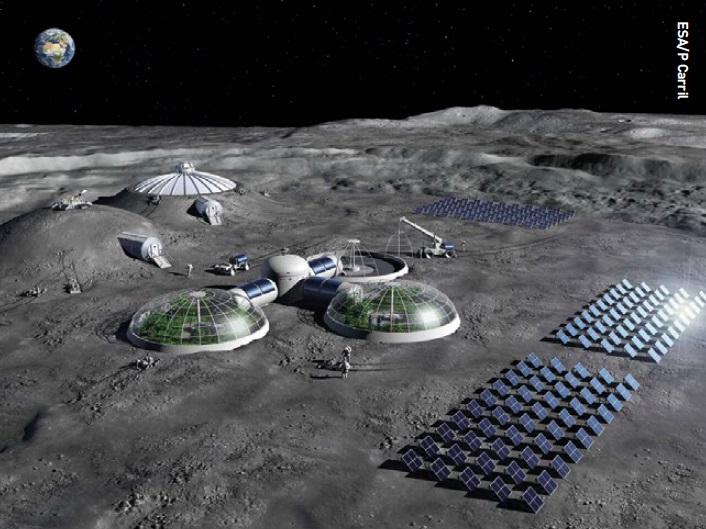 Artist impression of a lunar outpost.
Artist impression of a lunar outpost.
Challenges associated with long-duration missions intensify the demands on habitats and their design, system operations and integration. For instance, physical-chemical life-support systems become bulky for long durations or require huge effort for resupply (eg, filters or food). Mission administration, especially with several partners, becomes more complex for a long-duration mission as well. Therefore, new technologies have to be developed along with new processes and approaches to tackle those challenges.
Space habitats must serve to satisfy the needs of humans and their missions
A space habitat cannot be within just one discipline. Of course, engineering alone covers multiple fields, e.g., power supply, construction and thermal control. Nevertheless, other aspects are equally as important, even if they may not be as tangible as a physically existing habitat module. These aspects include governance, especially in case of international, collaborative missions, which requires legal considerations.
When planning and designing a habitat, social and cultural facets of life affect the design process. Human factors, including complications related to human physiology and psychology must be considered. For instance, when designing a greenhouse system, cultural aspects (especially for a non-homogenous crew) might determine the most likely crop to be accepted by the whole crew for food. Biological aspects influence nutrition, and technical aspects may influence crop selection based on the capability of a plant to revitalise the air and thus act as a part of bio-regenerative life-support system.
Economics is an important factor when finding commercial use cases and generally determining the costs and financing for a habitat. It may also play a part in determining incentives for fostering the creation and commercial support of space habitats.
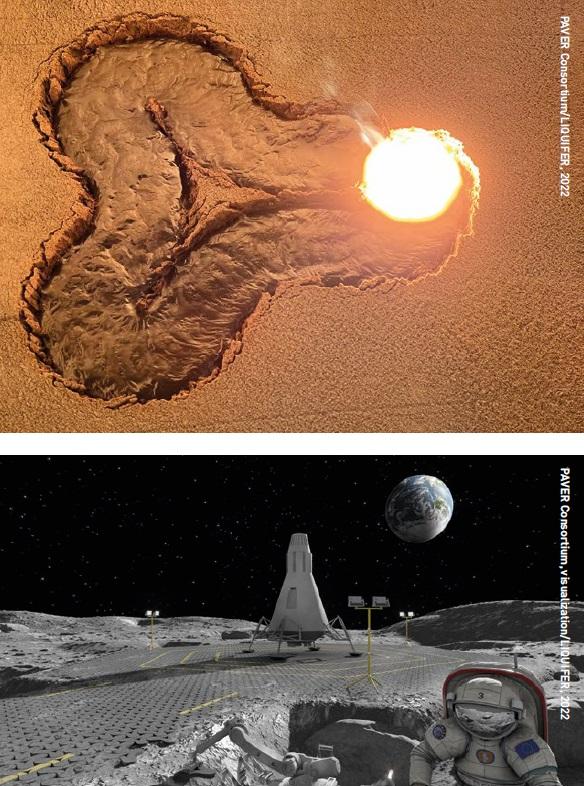 Fig 1: Top: Laser-melting of one interlocking geometry for the PAVER project using lunar soil simulant EAC-1A. Beam diameter: 5 cm, Laser power: 10 kW. Bottom: Interlocking paving elements on the Moon to mitigate dust in machinery and infrastructure.
Fig 1: Top: Laser-melting of one interlocking geometry for the PAVER project using lunar soil simulant EAC-1A. Beam diameter: 5 cm, Laser power: 10 kW. Bottom: Interlocking paving elements on the Moon to mitigate dust in machinery and infrastructure.
IAF Space Habitats Committee
The International Astronautical Federation (IAF) Space Habitats Committee was formed in 2021 with a diverse team of experts from all disciplines relevant to enabling human life in the harsh environments of space, be it orbital or on-ground, to improve the understanding of all aspects involved with that topic.
The Committee facilitates analyses and common studies and also promotes within the IAF, issues of space habitats, always regarding all the relevant disciplines including social, biological, medical, technical, economic, legal and many more.
At the same time, it acts as a channel of communication between the IAF and actors in the field of space habitats from academia, organisations, industry, etc. This way, it can report about research and development activities in the field of space habitats, propose standards for space habitat development and operation and support workshops and general activities in the field (figuratively and literally). The Committee aims at crossing knowledge and fostering trans-disciplinarity among its members.
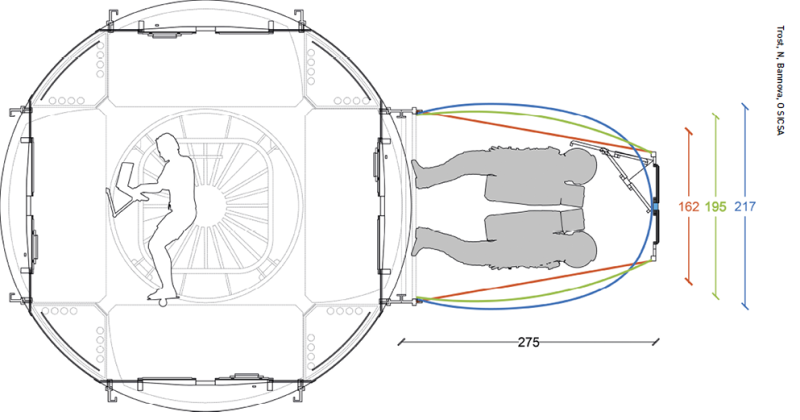 Fig 2: Deployable airlock concepts interior dimensions and geometries.
Fig 2: Deployable airlock concepts interior dimensions and geometries.
RESEARCH ACTIVITIES
When planning and designing a habitat, social and cultural facets of life affect the design outcome
Human factors, social sciences
Human factors and social sciences are very relevant aspects of space habitats that are reflected in the activities of the Space Habitats Committee and its members. For example, design theorist, Barbara Brownie, researches the relationship between clothes and the body in microgravity as encountered in spaceflights.
Microgravity makes every activity a new experience for those exposed to it, which includes the sensations of wearing clothes. This should be reflected in creative fashion design that takes into consideration the behaviour of fabrics and the dressed body in a weightless environment e.g., by diverting from close-fitting suits akin to early jet-age flight suits to a more non-functional but aesthetics-oriented design.
Eytan Tepper et al research the governance needed in a developing space environment inhabited by humans, and the role private corporations play in establishing space colonies and their laws and rules. Similar to historic constructs of overseas colonisation such as the British and the Dutch East India Company, the forerunners in ‘space colonisation’ might realise similar commercial success but will also run the risk of making the same mistakes, ranging from the use of autocratic power, to abuse of resident populations and the misuse of resources, that have been made by colonisers in the past.
The dominance of certain companies in space colonisation could reach a ‘quasi-sovereign’ status, which allows them to establish their own rules. These rules, the authors argue, should be adapted to the ‘public-ness’ of the corporation’s activities in space colonisation, prescribing rights and duties. This work echoes research and consultancy conducted by space lawyers and policy analysts, also members of the Committee, whose expertise ranges from Moon territorialisation and governance to in situ resources utilisation and corporate law.
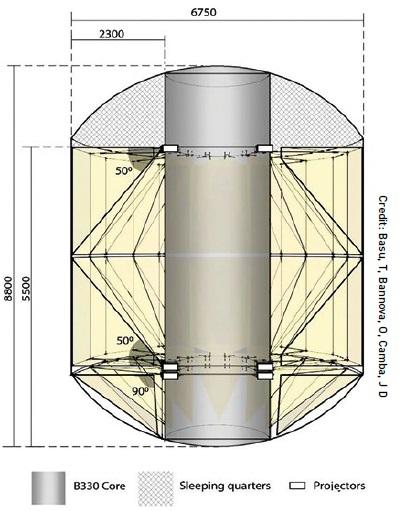 Fig 3: Final configuration of projection-based mixed reality system.
Fig 3: Final configuration of projection-based mixed reality system.
Justin Walsh and Alice Gorman are specialists in the emerging field of space archaeology. Their paper, ‘Archaeology of the International Space Station (ISS)’, investigates the first “mini-society off-world” in low Earth orbit, documenting human adaptation to a new and lasting environment for the past two decades and more. Research involves the interaction of crew members with each other and with technical equipment. Conflict and cooperation are researched, as is the influence of microgravity on social and cultural aspects of life aboard the ISS. This retrospective research helps to inform future habitat designs about social challenges arising from life on a space station.
The dominance of certain companies in space colonisation could reach a ‘quasi-sovereign’ status, which allows them to establish their own rules
Sandra Häuplik-Meusburger, architect and habitability researcher, has observed the relationship between the built environment and human activities in the space environment and during simulations studies on Earth, and has identified behavioural issues with mission and habitability design implications. Her latest cross-disciplinary work with psychologist Sheryl Bishop identifies basic human commonalities in extreme environments and how habitat design can address behavioural issues.
Articulating her background in sociology and her professional diving activities, Julie Patarin-Jossec investigates astronaut training and flight experience. In the continuity of her ethnography of the International Space Station programme, started in 2015, she uses the philosophy of architecture and ergonomics to study how the design of space habitats, transportation vehicles and suits act as a platform for circulating social norms and industrial standards (eg, interoperability) impacting crews’ embodiment process and identity-building. This research helps her develop training activities for commercial and analogue crews with an emphasis on underwater operations and sustainably-designed life support equipment.
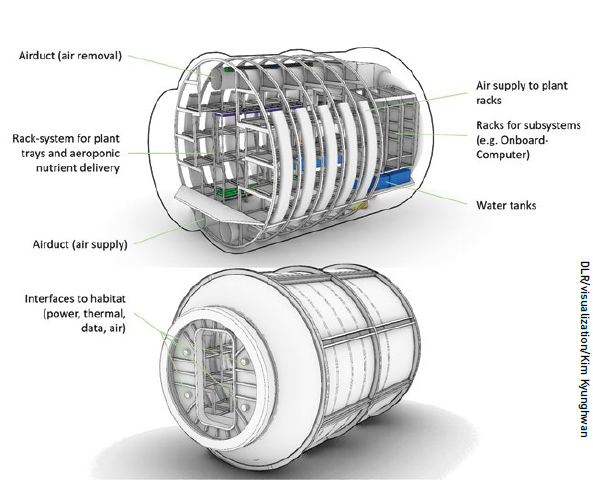 Fig 4: Top: Interior view of the ground test demonstrator (GTD) greenhouse’s current design with some components marked. Bottom: Exterior view of structure and interfaces.
Fig 4: Top: Interior view of the ground test demonstrator (GTD) greenhouse’s current design with some components marked. Bottom: Exterior view of structure and interfaces.
Technology, Infrastructure
The PAVER project by Barbara Imhof et al, a multi-disciplinary and multi-partner team (from Germany: TU Clausthal, BAM, Hochschule Aalen, from Austria: LIQUIFER), researches how pavement elements, fabricated from lunar regolith can be laser sintered into infrastructure such as roads and launch pads. Such infrastructure reduces problems resulting from dust produced by vehicles and landers.
The project aims at increasing the Technology Readiness Level (TRL) from three to five by testing the laser sintering of regolith simulants in a vacuum, where the laser steps in for a concentrated solar beam on the lunar surface (see Fig. 1). The ability of in situ manufacturing of infrastructure elements increases the sustainability of a future lunar settlement as new structures can be built with little effort and a lunar base can expand to various sites, interesting for applications, including science, resource utilisation and commercial applications.
Olga Bannova and her MS-Space Architecture students at Sasakawa International Center for Space Architecture (SICSA), Houston, Texas, investigate how to enable the evolutionary growth of infrastructures in cis-lunar space and on surfaces of the Moon and Mars.
Advancing sustainable human operations off-Earth should occur coherently and progressively. This requires evaluation of current design and planning strategies for manned space missions, and a competent understanding of concepts of operations, human needs and systems engineering requirements.
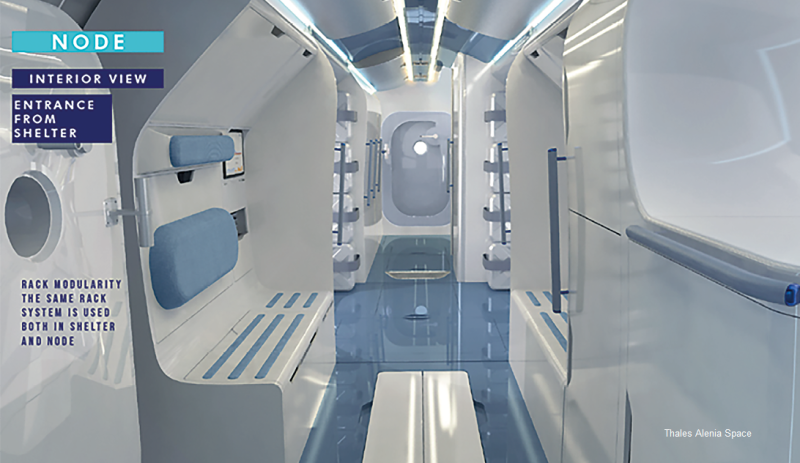 Fig 5: Lunar Habitat interior view.
Fig 5: Lunar Habitat interior view.
To avoid unnecessary additional deliveries of surface elements or modules and satisfy planetary protection regulations while enabling evolutionary growth, the design of base or settlement elements should allow repurposing them as needed, salvaging elements and parts to reuse or reprint if and when it is feasible. Primary and secondary structural components, interfaces and supporting elements – the design of all space architecture attributes needs to follow such an approach.
Defining an appropriate and feasible level of standardisation of habitat elements requires conducting multiple trade studies and the development of figures of merits (FOM) eg, power and technology requirements/capabilities, maintenance requirements.
Microgravity makes every activity a new experience for those exposed to it, which includes the sensations of wearing clothes
The synergy of knowledge from multiple disciplines about systems and human interactions and relationships allows habitats, bases, and settlements to evolve through enabling and adapting to new materials, construction methods and technologies - including thermal control, power generation and harvesting, hybrid structures, automation & robotics and closed-loop life-support systems.
This philosophy is applied not only in student projects but also in grant and contract studies conducted at SICSA. The sequence of multi-year grant research projects for Boeing included deployable airlock studies for orbital applications (Fig. 2), lunar lander study, habitability and lunar base studies of Boeing design for lunar orbital platform-gateway, and lunar surface systems study parts I and II.
Analysing the limitations and benefits of current virtual reality (VR) technologies applications for design verification purposes, a multiphased methodology has been developed that involves a mixed reality (MR) approach aiming to validate design decisions in connection with crew Concept of Operations evaluation. Another natural VR and MR application for space travel is psychological health support. That involves integration of these technologies in habitat design, estimation of system requirements and defining provisions for human interaction (Fig. 3).
Research on the latter is done by the EDEN group, represented in the committee by Volker Maiwald. The EDEN group has previously, in a multi-partner team, including Barbara Imhof and Liquifer which developed a prototype greenhouse, the EDEN ISS Mobile Test Facility (MTF), for the Moon and operated it in Antarctica at the German Neumeyer-III Research Station for several years. The MTF is returning to Germany this year to be refurbished and added to ESA’s LUNA facility to support analogue missions and research there.
As an intermediate step between MTF and an actual lunar greenhouse, the EDEN group is currently in the process of developing a ground test demonstrator (GTD). It will consist of three major components: a greenhouse (the actual component to be tested, see Fig. 4), a habitat simulator (simulating the interaction between a lunar habitat and the greenhouse, especially concerning material flows, ie, closed-loop) and a control centre.
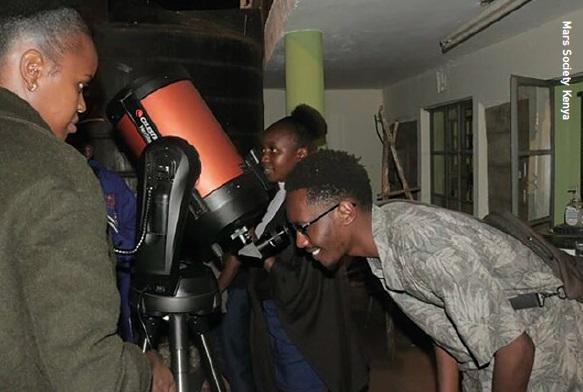 Fig 6: Mars Society Kenya engaging the public at the World Astronomy Day event in Kenya together with other space organisations. The Society’s goal is to create support for human Mars missions, inspiring and enabling new business opportunities and start-ups and reviving Kenya’s space industry.
Fig 6: Mars Society Kenya engaging the public at the World Astronomy Day event in Kenya together with other space organisations. The Society’s goal is to create support for human Mars missions, inspiring and enabling new business opportunities and start-ups and reviving Kenya’s space industry.
The GTD is designed to be a high-fidelity model of a lunar greenhouse to test and mature greenhouse technologies, processes and operations, as well as research relevant plant biology aspects to realise a bio-regenerative life-support system. The design has progressed into Phase A and operation is expected to begin in around 2025.
The ability of in situ manufacturing of infrastructure elements increases the sustainability of a future lunar settlement
Maria Antonietta Perino, has been working for many years at Thales Alenia Space on the design of different building blocks for Moon and Mars in-orbit and surface infrastructures, with particular regard to human factor issues for deep-space crewed missions.
The new modules for deep-space missions will exploit the background and knowledge developed in the design and construction of the ISS pressurised modules, injecting where possible new technologies currently available in terms of advanced materials, thermal and radiation protections, more autonomous life support and environmental control systems, internal layout architectures driven by a human-centred approach to provide larger habitable volumes and, above all, better internal comfort (Fig. 5).
Analogue Research, Education
Education is an important aspect of space habitat activities, especially to engage new contributors to habitat research, and testing processes, technologies and human factor issues require suitable analogue research sites, eg, with simulated habitats in harsh environments.
Isaac Gathu and Mars Society Kenya, the Kenyan chapter of the American-based but worldwide distributed non-profit organisation, aim at creating support for human Mars missions, inspiring and enabling new business opportunities and start-ups and reviving Kenya’s space industry. One way to achieve these goals and enable research related to space habitats, is the planned set-up of a Mars habitat simulation programme, by building and operating a Mars Desert Research Station (MDRS) akin to the facilities the Mars Society operates in the United States.
Furthermore, Mars Society Kenya will create a ‘Space City’, an educational campus for advancing domestic education on space-related issues (see Fig. 6) in cooperation with the Italian Space Agency, the University of Nairobi and the University of Rome.
The Lunar Greenhouse studio project 2021/2022, was held in cooperation between Abu Dhabi University (ADU) represented by Paolo Caratelli, and TU Wien (TUW) represented by Sandra Haeuplik-Meusburger, both members of the Committee.
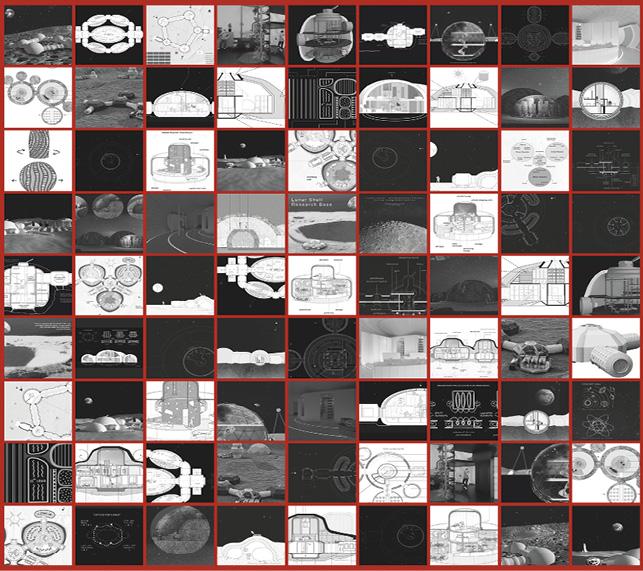 Fig 7: Selection of intercultural student projects from the joint design studio of TU Wien and Abu Dhabi University.
Fig 7: Selection of intercultural student projects from the joint design studio of TU Wien and Abu Dhabi University.
The topic of this coordinated design studio project (Fig. 7), attended by 60 students and with the participation of several space professionals as guest lecturers, focused on research and design for a lunar permanent outpost integrated with a greenhouse, permanently inhabited by eight crewmembers, and located at the lunar south pole near the Shackleton crater.
The design of base or settlement elements should allow repurposing them as needed, salvaging elements and parts to reuse or reprint if and when it is feasible
The topic gave students the opportunity to delve into principles of bioregenerative closed loop systems, thermal and micrometeoroid protection, radiation shielding, and in situ resource utilisation (ISRU). The multidisciplinary approach and the heterogeneity of working groups, composed by mixed students of the two universities and belonging to 26 different nationalities, also provided the opportunity to analyse the potential psychophysiological and cultural issues that a crew could experience in an isolated confined extreme (ICE) environment, and possible remedies through spatial design.
The project and the outcomes were presented at EXPO in Dubai, at the Technical Session of the 65th General Assembly of UNOOSA in Vienna, and as an interactive presentation at the 73rd IAC in Paris. A follow-up research project has been funded with a research grant from the Office of Research and Sponsored Programs of ADU.
Interdisciplinary thinking and working
It is evident that the activities of the IAF Space Habitat Committee, originating from various disciplinary frameworks and know-how, constantly interconnect in the course of these projects.
Experimentation can be done in relevant environments, such as a Mars analogue programme in Kenya, and infrastructure construction like PAVER, is extremely relevant for durable mission planning and design, which can contain further elements enabling sustainability for long-duration missions like greenhouses, such as EDEN.
Living aboard space habitats is also researched by human factors and social studies, which can further inform and influence habitat designs in the future.
Unlike past space station infrastructures, whose primary utilisation was to support scientific and technological experimentation both for terrestrial benefits and the preparation of long-duration flights beyond LEO, space habitation in the coming decade will have to deal both with new challenges (eg, the loss of visual reference to the Earth) and the diversification of crew profiles inducing new dwelling standards (from space tourists and philanthropists to artists and media crews).
Implementing a productive dialogue among fields which have their own frameworks, methodologies and institutional networks has never been an easy task - but neither is space exploration
In the continuity of other existing initiatives, the Space Habitats Committee relies on the conviction that this cannot be achieved by a single field of expertise, but rather requires fostering interdisciplinary thinking, if not trans-disciplinary teams.
Implementing a productive dialogue among fields which have their own frameworks, methodologies, and institutional networks has never been an easy task - but neither is space exploration. Developing a ‘space’ where these different skills can meet and lead to common initiatives seems like a good start.
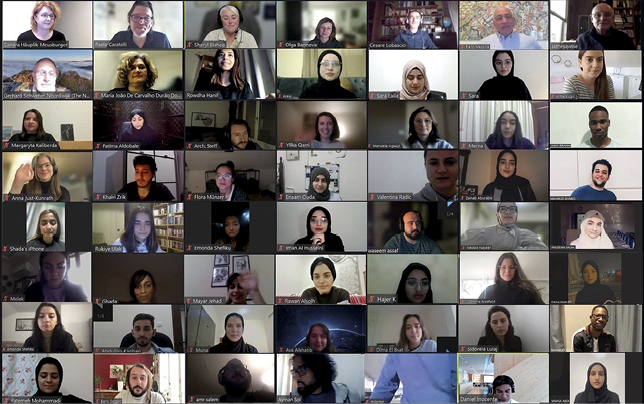 Zoom meeting showing the students from 26 countries along with the studio directors and guest lecturers on the day of the final critique.
Zoom meeting showing the students from 26 countries along with the studio directors and guest lecturers on the day of the final critique.
About the authors
Volker Maiwald is a system and mission analyst for DLR with a PhD in the field of low-thrust trajectory optimisation from Bremen University. He has been a lecturer in spaceflight dynamics at the University of Bremen since 2012 and has led more than 30 early design studies and been systems engineer for early mission phases. His current study focus is on human habitats, space greenhouse systems and sustainability.
Julie Patarin-Jossec has a PhD on the colonial politics of outer space exploration and the social dynamics of astronaut training. She is a visual studies scholar, professional diver and documentary filmmaker. She is the author of Manufacturing the astronaut: an earthly ethnography of the International Space Station, tens of academic and media publications, and several film and photography projects.
Olga Bannova is a Research Professor at the University of Houston’s Cullen College of Engineering, Director of the world’s only Master of Science in Space Architecture programme and Sasakawa International Center for Space Architecture. She conducts research and design studies of orbital and surface habitats and settlements, including inflatable structures, special design influences and requirements for different gravity conditions in space, and habitat concepts for extreme environments on Earth. She is a co-author of Space Architecture Education for Engineers and Architects (2016), and the author of Space Architecture: Human Habitats beyond the Planet Earth (2021), for which she received the Social Sciences Book Award of the International Academy of Astronautics, as well as many book chapters and dozens of technical publications.
Maria Antonietta Perino is Director International Network Opportunities Development at Thales Alenia Space. She is involved in different activities promoting the development of young professionals in the space industry and is a member of the International Space University Academic Council. She is the author of several publications, papers, and reports, and is Co-editor of Acta Astronautica. Maria Antonietta is a member of the Académie de l’Air et de l’Espace and the International Academy of Astronautics, and former IAF Bureau Vice President. She is President of Explore Mars Europe, a Board of Directors member of Women in Aerospace-Europe, International Lunar Observatory Association and World Space Week Association. In 2010 she received the Woman of Excellence award from AIDDA, the Italian association for women with leadership and in 2019 was awarded the Stella al Merito del Lavoro by the President of Italy.
Sandra Häuplik-Meusburger is a researcher at TU Wien and a practicing architect in habitability design solutions for compact and extreme environments. She has published several books and scientific papers, worked on aerospace design and research projects and is a full member of the International Academy of Astronautics (IAA) and upcoming chair for the Space Architecture Technical Committee (SATC) of the American Institute of Aeronautics and Astronautics (AIAA).





